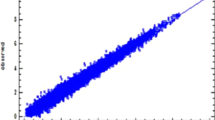Abstract
In traditional artificial neural networks (ANN) models, the relative importance of the individual meteorological input variables is often overlooked. A case study is presented in this paper to model monthly wind speed values using meteorological data (air pressure, air temperature, relative humidity, and precipitation), where the study also includes an estimate of the relative importance of these variables. Recorded monthly mean data are available at a gauging site in Tabriz, Azerbaijan, Iran, for the period from 2000 to 2005, gauged in the city at the outskirt of alluvial funneling mountains with an established microclimatic conditions and a diurnal wind regime. This provides a sufficiently severe test for the ANN model with a good predictive capability of 1 year of lead time but without any direct approach to refer the predicted results to local microclimatic conditions. A method is used in this paper to calculate the relative importance of each meteorological input parameters affecting wind speed, showing that air pressure and precipitation are the most and least influential parameters with approximate values of 40 and 10 %, respectively. This gained knowledge corresponds to the local knowledge of the microclimatic and geomorphologic conditions surrounding Tabriz.





Similar content being viewed by others
Explore related subjects
Discover the latest articles and news from researchers in related subjects, suggested using machine learning.References
Abrahart RJ, See L, Kneale P (2001) Investigating the role of saliency analysis with a neural network rainfall-runoff model. Comput Geosci 27(8):921–928, http://www.sciencedirect.com/science/article/pii/S009830040000131X
Bilgili M, Sahin B (2010) Comparative analysis of regression and artificial neural network models for wind speed prediction. Meteorol Atmos Phys 109:61–72
Bilgili M, Sahin B, Yasar A (2007) Application of artificial neural networks for the wind speed prediction of target station using reference stations data. Renew Energy 32:2350–2360
Costa A, Crespo A, Navarro J, Lizcano G, Madsen H, Feitosa E (2008) A review on the young history of the wind power short-term prediction. Renew Sustain Energy Rev 12(6):1725–1744
El Fouly THM, El-Saadany EF (2012). Grey predictors for hourly wind speed and power forecasting. Wind Energy Conversion Systems—Green Energy and Technology, pp 197–226; (http://link.springer.com/chapter/10.1007/978-1-4471-2201-2_9)
Elmolla ES, Chaudhuri M, Eltoukhy MM (2010) The use of artificial neural network (ANN) for modeling of COD removal from antibiotic aqueous solution by the Fenton process. J Hazard Mater 179:127–134
Garson GD (1991) Interpreting neural-network connection weights. AI Expert 6:47–51
Gong L, Jing S (2010) On comparing three artificial neural networks for wind speed. Forecast Appl Energy 87:2313–2320
Haykin S (1999) Neural networks: a comprehensive foundation, 2nd edn. Prentice Hall, Upper Saddle River
Kaldellis JK, Kavadias KA, Filios AE (2009) A new computational algorithm for the calculation of maximum wind energy penetration in autonomous electrical generation systems. Appl Energy 86(7–8):1011–1023
Kisi Ö (2005) Daily river flow forecasting using artificial neural networks and auto-regressive models. Turk J Eng Environ Sci 29:9–20
Lippmann RP (1987) An introduction to computing with neural nets. IEEE ASSP Magazine April: pp 4–22
Makarynskyy O, Makarynskyy D, Kuhn M, Featherstone WE (2004) Predicting sea level variations with artificial neural networks at Hillarys Boat Harbour. West Aust Estuar Coast Shelf Sci 61:351–360, http://geodesy.curtin.edu.au/local/docs/will_pubs/nuralnet.pdf
McCulloch WS, Pitts W (1943) A logical calculus of the ideas immanent in neurons activity. Bull Math Biophys 5:115–133
Melesse AM, Hanley RS (2005) Artificial neural network application for multi ecosystem carbon flux simulation. Ecol Model 189:305–314
Monfared M, Rastegar H, Kojabadi H (2009) A new strategy for wind speed forecasting using artificial intelligent methods. Renew Energy 34(3):845–848
Ozgoren M, Bilgili M, Sahin B (2012) Estimation of global solar radiation over Turkey. Experts Syst Appl 39:5043–5051
Sfetsos A (2000) A comparison of various forecasting techniques applied to mean hourly wind speed time series. Renew Energy 21(1):23–35
Tang Z, Fishwick PA (1993) Feedforward neural nets as models for time series forecasting. ORSA J Comput 5(4):374–385
Ucar A, Balo F (2009) Investigation of wind characteristics and assessment of wind-generation potentiality in Uludag-Bursa, Turkey. Appl Energy 86(3):333–339
Varshney K, Poddar K (2012) Prediction of wind properties in urban environments using artificial neural network. Theor Appl Climatol 107(3–4):579–590, http://link.springer.com/article/10.1007%2Fs00704-011-0506-9
Winkler W (2012) Long-term wind speed trends in Germany http://www.gl-garradhassan.com/assets/downloads/Long_Term_Wind_Speed_Trends_in_Germany.pdf
Wong FS (1992) Time series forecasting using backpropagation neural network. Neurocomputing 2:147–159
Xydis G, Koroneos C, Loizidou M (2009) Energy analysis in a wind speed prognostic model as a wind farm sitting selection tool, a case study in Southern Greece. Appl Energy 86(11):2411–2420
Author information
Authors and Affiliations
Corresponding author
Rights and permissions
About this article
Cite this article
Ghorbani, M.A., Khatibi, R., Hosseini, B. et al. Relative importance of parameters affecting wind speed prediction using artificial neural networks. Theor Appl Climatol 114, 107–114 (2013). https://doi.org/10.1007/s00704-012-0821-9
Received:
Accepted:
Published:
Issue Date:
DOI: https://doi.org/10.1007/s00704-012-0821-9




